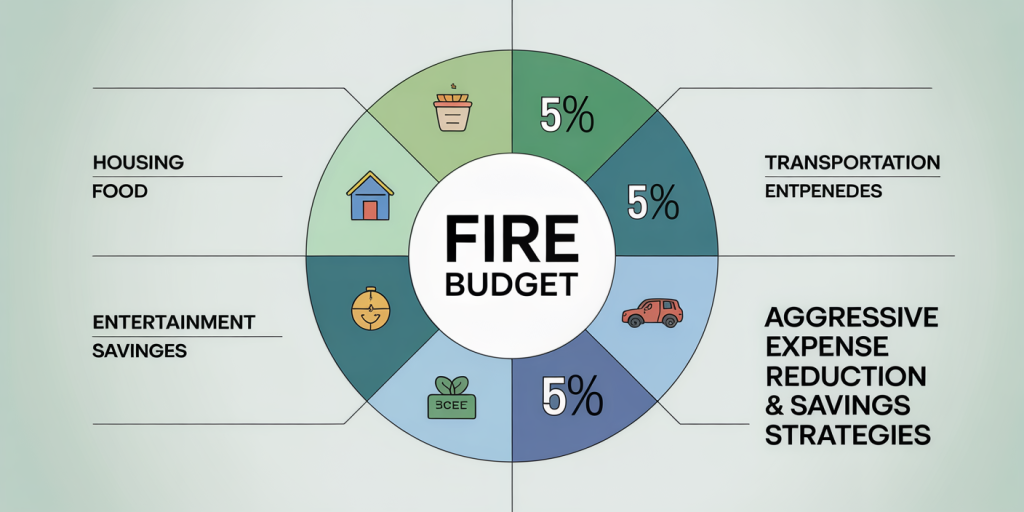The concept of FIRE—Financial Independence, Retire Early—has gained massive popularity in recent years as more people seek to break free from the conventional work timeline and retire decades before the standard retirement age. Achieving FIRE is not just about hoarding wealth but implementing a meticulously planned budget that supports reduced expenses while maximizing savings and investments. Crafting a FIRE budget requires precision, discipline, and a strategic mindset to ensure long-term sustainability. This article delves into creating an effective FIRE budget, backed by practical examples, data, and comparative analysis.
Understanding the Core of FIRE Budgeting
Financial Independence means having enough income from your investments or passive income streams to cover your living expenses indefinitely. Early Retirement pushes this notion further by targeting a timeline usually before age 50 or even 40. To meet these goals, a FIRE budget adopts an aggressive savings rate, typically between 50% to 70% of income, depending on how early you want to retire.
The first step in developing a FIRE budget is understanding your baseline expenses with a realistic eye. According to a 2022 survey by the U.S. Bureau of Labor Statistics, average annual expenditure for a U.S. household was approximately $65,000. For FIRE seekers, trimming this down significantly is crucial. Reducing expenses in housing, transportation, food, and entertainment will directly impact how fast one can retire early.

Consider the case of Chris and Julia, a couple in their early 30s from Portland, Oregon. They earn a combined $120,000 a year but managed to cut their expenses to $36,000 annually by downsizing their home, cooking most meals at home, switching to a used hybrid vehicle, and minimizing discretionary spending. Their savings rate soared above 70%, allowing them to accumulate a nest egg allowing for early retirement by age 42.

Components of a FIRE Budget: Fixed vs. Variable Expenses
Budgeting for FIRE requires careful separation of fixed and variable expenses. Fixed expenses such as rent/mortgage, insurance, and utilities are generally non-negotiable, while variable expenses like dining out, entertainment, and travel offer flexibility.
Fixed Expenses Optimization
Housing often makes up the largest chunk of fixed expenses, typically about 30% of most budgets. FIRE adherents often seek alternatives such as purchasing smaller homes, relocating to lower-cost areas, or even house hacking—renting spare rooms or converting properties into multi-family units to generate income and reduce personal housing costs.
For example, consider two individuals: Alex lives in San Francisco with a $3,500 monthly rent, whereas Sam lives in Boise, Idaho, with a $1,200 rent for similar housing. By relocating to Boise, Sam saves $2,300 per month or $27,600 annually, a significant boost to savings rate.
Insurance premiums, utility bills, and subscriptions should be regularly reviewed and renegotiated when possible. Sharp attention to these fixed costs can provide predictable, manageable monthly expenses conducive to budgeting for early retirement.
Variable Expenses Make-or-Break Flexibility
Dining out, vacations, hobbies, and transportation outside of basic commuting can balloon expenses without much notice. A practical strategy for FIRE budgeting involves creating a “fun money” category with strict monthly limits, reducing impulse spending, and focusing on low-cost or no-cost recreational activities.
Using Chris and Julia’s example, they swapped frequent dining out for meal prepping, reducing their food bills by 40%. Similarly, travel was limited to affordable options like road trips and camping rather than costly international travel.
Comparative Table: Typical vs. FIRE Budget Expense Allocation
| Expense Category | Typical Monthly Spend | FIRE Monthly Spend | Percentage Reduction |
|---|---|---|---|
| Housing | $1,800 | $900 | 50% |
| Food | $600 | $360 | 40% |
| Transportation | $500 | $250 | 50% |
| Entertainment | $300 | $100 | 66% |
| Insurance & Utilities | $400 | $350 | 13% |
| Miscellaneous | $200 | $90 | 55% |
| Total | $4,800 | $2,050 | 57% |
This table illustrates how aggressive expense management can more than halve monthly spending, accelerating the savings journey to early retirement.
Prioritizing Savings Rate and Investment Returns
The crux of a FIRE budget lies in a high savings rate. Camp FIRE (Conventional Retirement by 65 Fire) suggests a 15-20% savings rate, but early retirees often save upwards of 50%. Higher savings rates capitalize on compound interest and investment growth over time, shrinking the time horizon to early retirement.

Data from the Barclays Equity Gilt Study (2023) indicate that portfolios with diversified investments—index funds, bonds, and dividend-paying stocks—and an average annualized return of 7% enable financially independent individuals to retire 10-15 years earlier than those relying solely on savings accounts or CDs yielding 1-2%.
Real-life case: Mr. Tom, a software engineer, saved 70% of his income by living frugally and automating investments into low-fee index funds. At an average 7% return, he retired at 38 with a portfolio valued at $1.2 million. His FIRE budget allowed maximizing investment while keeping expenses low.
It is essential while budgeting for FIRE to forecast future expenses conservatively and factor in inflation. Using a 3% annual inflation rate, a $40,000 annual budget will cost nearly $53,000 in 10 years. Thus, savings targets must surpass current expense levels significantly.
Emergency Funds and Safety Nets in a FIRE Budget
While the FIRE philosophy promotes aggressive savings, having a robust emergency fund is indispensable. Unexpected expenses such as medical emergencies, home repairs, or economic downturns can derail early retirement plans if unplanned for.
Financial advisors typically recommend three to six months of living expenses in liquid savings for emergencies. However, in a FIRE budget, reserving six to twelve months is prudent, due to the longer time horizons and greater responsibility of self-funded retirement.
Sarah, a 35-year-old FIRE aspirant, maintains an emergency fund of $30,000—approximately nine months of living expenses for her $40,000 annual budget. This provides psychological comfort and reduces the risk of withdrawing investments at a loss during market downturns.
Budgeting for emergency funds means allocating a portion of monthly savings towards liquidity, which may reduce the speed of financial independence but strengthens the foundation for sustainable early retirement.
Accounting for Healthcare and Insurance Post Early Retirement
Healthcare is one of the most challenging expenses for early retirees, especially in the United States, where employer-provided insurance usually ends upon retirement. Budgeting for healthcare premiums, out-of-pocket expenses, and supplemental insurance is critical in a FIRE plan.
Estimates from the Kaiser Family Foundation (2024) show the average annual premium for a single 40-year-old purchasing an individual health plan is approximately $6,000, with additional possible out-of-pocket costs. Early retirees must budget this as a fixed necessity rather than an optional expense.
Some early retirees opt for Health Savings Accounts (HSAs) during their employed years to cover future expenses, while others explore medical cost-sharing plans or move to countries with lower healthcare costs.
For example, the Brown family, retired at 45, relocated from New York to Costa Rica where healthcare costs are significantly lower. Their FIRE budget anticipated and accommodated these healthcare expenses, allowing them to maintain quality care while reducing costs by over 50%.
Future Perspectives: Adapting Your FIRE Budget in a Changing World
The path to early retirement does not end upon hitting your savings target. Maintaining a sustainable FIRE lifestyle requires ongoing budgeting and adaptability. Market volatility, changing personal circumstances, and unexpected inflation can all impact your nest egg.
Technology advancements, such as fintech budgeting tools and robo-advisors, allow FIRE retirees to track expenses and optimize investment portfolios continuously. Increased access to passive income through digital assets or dividend investments can complement traditional FIRE strategies.
Additionally, the growing popularity of the “Lean FIRE” (minimalist lifestyle with very tight budgets) and “Fat FIRE” (maintaining a more comfortable, higher spending level) options necessitates flexible budgeting to match evolving life goals.
For instance, tracking your spending monthly with apps like YNAB (You Need A Budget) or Mint can reveal new saving opportunities and help stay aligned with FIRE goals. Regularly revisiting your asset allocation based on changing risk tolerance and market conditions ensures your investments continue supporting early retirement.
Emerging trends, such as remote work and the gig economy, also allow partial work during early retirement, supplementing income without fully returning to traditional jobs. This hybrid approach may reshape FIRE budgeting by adding variable income streams.
Creating a FIRE budget that supports early retirement demands intentional expense management, aggressive savings, and prudent planning for unpredictable costs like healthcare and emergencies. With data-driven strategies, practical adaptations, and continuous monitoring, achieving financial independence early is a realistic and sustainable goal for many aspiring retirees. Whether you aim for Lean or Fat FIRE, the key is to build a flexible budget rooted in your unique lifestyle aspirations and financial reality.

Deixe um comentário